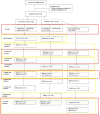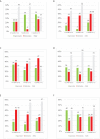Real Life Data on Patient-Reported Outcomes and Neuro-Cognitive Functioning of Lung Cancer Patients: The PRO-Long Study
- PMID: 34222010
- PMCID: PMC8247464
- DOI: 10.3389/fonc.2021.685605
Real Life Data on Patient-Reported Outcomes and Neuro-Cognitive Functioning of Lung Cancer Patients: The PRO-Long Study
Abstract
Introduction: This report investigates the impact of systemic treatments (chemotherapy or immunotherapy) with(out) loco-regional radiotherapy, on HRQoL, toxicity and neurocognitive functioning (NCF) in locally advanced and metastatic non-small cell lung cancer patients enrolled in the PRO-Long study.
Materials and methods: Data on patient-reported HRQoL and fourteen toxicities was collected, while NCF was tested, up to one-year post-treatment. HRQoL was assessed using the European Organisation for Research and Treatment of Cancer QLQ-C30. Lung cancer, treatment and neuro-psychological related toxicities were scored with the Patient-Reported Outcomes version of the Common Terminology Criteria for Adverse Events. NCF was evaluated with six neurocognitive tests. Mixed model analyses were conducted to determine statistical significance (p = .01). Meaningful clinical important differences (MCIDs) were applied for changes in HRQoL and NCF data, while toxicities were compared to baseline values.
Results: In total, 50 patients were enrolled. Overall HRQoL (p = .357) nor its domains (physical, p = .643; role, p = .069; emotional, p = .254; cognitive, p = 494; social, p = .735) changed significantly over time. Meaningful improvements in overall HRQoL were seen in 22, 38 and 39% and deteriorations in 22, 5 and 28% of patients at 2-3, 6 and 12 months respectively post-treatment. Overall toxicity (p = .007), lack of appetite (p = .001), nausea (p = .004) and dysphagia (p = .000) significantly decreased over time. Treatment caused acute toxicity, such as dyspnoea (45%) and memory problems (42%), but also alleviated pre-existing symptoms, including lack of appetite (32%), anxiety (29%) and depression (28%) at 2/3 months. The NCF domains of visual memory (p = .000) and cognitive processing speed (p = .000) showed significant improvements over time. In terms of MCIDs, at 2-3 months (18%) and 6 months (15%), verbal memory was particularly impacted; at 12 months, visual memory (18%) and executive function (18%) deteriorated primarily.
Conclusion: The results suggest that therapy has no significant negative impact on overall HRQoL, its domains, and NCF. About one-third of patients reported a meaningful improved HRQoL at 1 year post-treatment. Treatment caused toxicity, but also alleviated pre-existing symptoms.
Keywords: health-related quality of life; neuro-cognition; non-small cell lung cancer; patient-reported outcome; real-life data; toxicity.
Copyright © 2021 Van Der Weijst, Surmont, Schrauwen and Lievens.
Conflict of interest statement
The authors declare that the research was conducted in the absence of any commercial or financial relationships that could be construed as a potential conflict of interest.
Figures



References
-
- Cortellini A, Friedlaender A, Banna GL, Porzio G, Bersanelli M, Cappuzzo F, et al. Immune-Related Adverse Events of Pembrolizumab in a Large Real-World Cohort of Patients With NSCLC With a PD-L1 Expression ≥ 50% and Their Relationship With Clinical Outcomes. Clin Lung Cancer (2020) 21:498–508.e2. 10.1016/j.cllc.2020.06.010 - DOI - PubMed
-
- Magee DE, Hird AE, Klaassen Z, Sridhar SS, Nam RK, Wallis CJD, et al. Adverse Event Profile for Immunotherapy Agents Compared With Chemotherapy in Solid Organ Tumors: A Systematic Review and Meta-Analysis of Randomized Clinical Trials. Ann Oncol (2020) 31:50–60. 10.1016/j.annonc.2019.10.008 - DOI - PubMed
LinkOut - more resources
Full Text Sources

